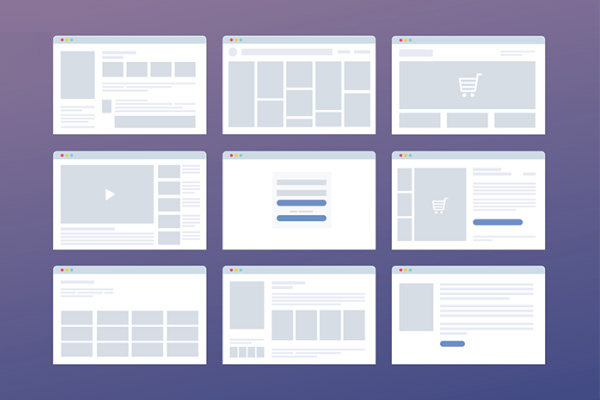When is creative too creative?

When it comes to launching or rebuilding a website, one of the most common questions we hear from small business owners is: how many website pages do I really need?
It’s a valid question. And the answer isn’t “as many as possible.” It’s about creating the right pages—the ones that support your goals, guide your visitors, and turn attention into action.
In this guide, we’ll break down which website pages are essential, which ones add value, and how to structure them for clarity, conversion, and SEO.
- Why Website Page Count Matters
- At a Minimum, You Need These 5 Website Pages
- Additional Website Pages That Add Value
- Case Studies or Project Portfolio
- Blog or Resource Hub
- Service Subpages
- Location Pages (if you serve multiple areas)
- FAQ Page
- How to Structure Website Pages for SEO and UX
- Internal Linking Strategy
- Write Page Titles and Meta Descriptions That Match Search Intent
- What If I’m Just Starting Out?
- How Many Website Pages Is Too Many?
- Build for Users First, Then Google
- Want Expert Help Structuring Your Website?
- FAQS
Why Website Page Count Matters
You don’t need a hundred pages to have a high-performing website. But you do need the right pages, in the right order, built with your audience in mind.
Too few pages, and your site feels thin or vague. Too many, and your message gets lost. The sweet spot depends on what you offer, who you serve, and what actions you want visitors to take.
Website structure isn’t just a technical SEO topic—it’s about helping users find what they need quickly and confidently.
At a Minimum, You Need These 5 Website Pages
Every small business should start with five foundational pages. These are the pages visitors expect—and search engines reward.
1. Home Page
This is your digital storefront. It should clearly state:
- What you do
- Who you serve
- How to take the next step
Use strong, benefit-led headlines and clear calls to action. Link to your core service pages. Don’t overcrowd it with too much detail—focus on clarity and flow.
2. About Page
This page builds trust. It tells your story, introduces your team (if relevant), and shares your values. But make no mistake—this isn’t just a bio page. Your About page should explain how your background benefits the client.
3. Services or Products Page
- What do you offer, and why should someone choose you? This page should:
- Clearly explain your services or products
- Highlight your point of difference
- Use plain English and customer-focused language
For SEO, consider breaking this into separate service pages (e.g. Web Design, SEO, Copywriting), especially if you serve multiple verticals or service areas.
4. Testimonials or Social Proof
Even one or two quotes from happy clients can build credibility. Ideally, include names, companies, or industries if possible. If you have case studies or Google Reviews, link to them here.
5. Contact Page
Make it easy to reach you. Use a contact form instead of publishing your email address directly. Include:
- Phone number
- Business location (if relevant)
- Contact hours
Additional Website Pages That Add Value
Once the core pages are in place, the next step is expansion. These pages build trust, boost SEO, and support your sales process.
Case Studies or Project Portfolio
A great way to show—not just tell—how you deliver results. Focus each case study on a specific client problem, your solution, and measurable outcomes.
Blog or Resource Hub
A blog helps attract organic traffic, answer common questions, and support your SEO goals. It also keeps your site fresh—something search engines reward.
Write for your ideal client. Focus on pain points, how-to guides, and industry insights. Link to your service pages naturally.
Service Subpages
If you offer more than one main service, give each one its own page. This helps users find exactly what they’re looking for—and gives each offer a chance to rank in search results.
Example:
- eComemrce Web Design
- WordPress Website Design
- SEO Brisbane
Each subpage should follow a similar structure: problem, solution, outcomes, CTA.
Location Pages (if you serve multiple areas)
If you’re targeting more than one suburb, city, or region, consider creating tailored location pages. For example:
Use these pages to include location-specific keywords, testimonials, and local insights.
FAQ Page
Answer the questions you get all the time. This helps:
- Reduce friction in the sales process
- Improve your SEO (Google loves FAQs)
- Support user experience
- Legal and Policy Pages
- Every business site should include:
- Privacy Policy (required by law in Australia)
- Terms & Conditions (especially for eCommerce)
- Cookie Policy (if tracking visitors)
They may not be glamorous, but they’re essential.
How to Structure Website Pages for SEO and UX
It’s not just about having the right pages. How you link them, label them, and lay them out matters.
Use a Clear, Logical Navigation Menu
Stick to top-level items like:
- Home
- About
- Services (with dropdowns)
- Blog or Resources
- Contact
Avoid crowded menus with too many options. Use your footer for secondary links like Terms, FAQ, or Login.
Internal Linking Strategy
Link from one page to another using descriptive anchor text:
- From your Home page to your Services
- From blog posts to relevant service pages
- From About to Testimonials
This helps visitors explore your site—and helps search engines understand your structure.
Write Page Titles and Meta Descriptions That Match Search Intent
Each page should have:
- A unique title (under 60 characters)
- A compelling meta description (under 150 characters)
- A target keyword (like “SEO Brisbane”, or “WordPress Website Design”)
- Use the keyword early in the content, in one subheading, and naturally throughout.
For a deeper dive, check out Google’s SEO Starter Guide.
What If I’m Just Starting Out?
Don’t worry about building 20 pages right away. Focus on:
- The core 5 pages
- 1–2 high-value service pages
- A blog or FAQ section (even if small)
You can add more over time. Quality beats quantity—especially for small business websites.
How Many Website Pages Is Too Many?
It depends on your audience, services, and SEO goals. A 10–20 page site is common for small businesses with multiple offerings. But if you’re adding pages just to boost page count, you’re missing the point.
Each page should:
- Serve a purpose
- Be easy to find
- Be well-written and designed to convert
If it doesn’t check those boxes, it shouldn’t be live.
Build for Users First, Then Google
Your website should help people first—Google second. A well-structured site with valuable, scannable content will naturally perform well.
The right website pages help your visitors navigate, learn, and take action. Whether you’re launching from scratch or restructuring an old site, page planning isn’t optional—it’s foundational.
Want Expert Help Structuring Your Website?
Scorched Media helps Brisbane businesses create websites that work—on screen and in search. Contact Scorched Media to discuss your website goals and organise a a website planning session.
We’ll map the right website pages for your goals and ensure each one is built to convert.
FAQS
1. What are the most important website pages to include?
Every business website should have five core pages: Home, About, Services or Products, Testimonials or Reviews, and a Contact page. These pages help visitors understand who you are, what you offer, and how to get in touch.
2. How many website pages do I need for good SEO?
There’s no magic number, but quality matters more than quantity. Aim for at least 5–10 well-structured pages that match your services and location. Adding blog posts, service subpages, and FAQs can also boost SEO.
3. Should each service have its own page?
Yes. If you offer more than one service, each should have its own page. This makes it easier for users to find what they need and helps each page rank better in search engines.
4. Can I start with just a few website pages?
Absolutely. Start with the essentials—then build over time. Focus on doing a few pages well before adding more. You can always grow your site as your business grows.
5. What makes a good website page?
A good page has a clear purpose, helpful content, easy navigation, and a strong call to action. It should be written for your audience and include keywords naturally, like “website pages” if that’s what people are searching for.




